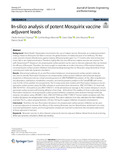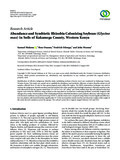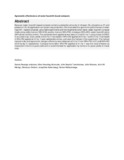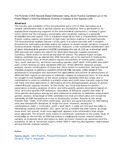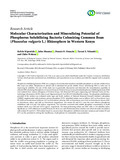Search
Now showing items 1-10 of 32
Genetic diversity of symbiotic bacteria nodulating common bean (Phaseolus vulgaris) in western Kenya
(Plos One, 2018-11-15)
Biological nitrogen fixation (BNF) in legumes plays a critical role in improving soil fertility. Despite this vital role, there is limited information on the genetic diversity and BNF of bacteria nodulating common bean ...
Abundance and Symbiotic Potential of Common Bean (Phaseolus vulgaris) Nodule Associated Bacteria in Western Kenya Soil
(Journal of Agricultural Science, 2016-07-10)
Plant growth-promoting Rhizobacteria are beneficial native soil bacteria that colonize plant roots and result in increased plant growth. Those that colonise the nodules of legumes are known as nodule associated ...
In-silico analysis of potent Mosquirix vaccine adjuvant leads
(Journal of Genetic Engineering and Biotechnology, 2023-11-30)
Background
World Health Organization recommend the use of malaria vaccine, Mosquirix, as a malaria prevention strategy. However, Mosquirix has failed to reduce the global burden of malaria because of its inefficacy. The ...
Abundance and Symbiotic Rhizobia Colonizing Soybean (Glycine max) in Soils of Kakamega County, Western Kenya
(International Journal of Agronomy, 2021-08-12)
Identification of effective indigenous rhizobia strain nodulating soybean (Glycine max) was conducted in Kakamega County, Western Kenya. This study was carried out to establish the abundance and symbiotic efficiency of ...
Agronomic effectiveness of water hyacinth-based composts
(African Journal of Agricultural Research, 2018-09)
Because water hyacinth-based compost contains substantial amounts of nitrogen (N), phosphorus (P) and potassium (K) its application can boost crop production. We evaluated the agronomic performance of water hyacinth - based ...
Spatial Modeling of Sorghum (Sorghum bicolor) growing areas in Kenyan Arid and Semi-Arid Lands
(Elixir Remote Sensing, 2014-01-10)
Sorghum (Sorghum bicolor) is an important African cereal crop and is listed among Africa’s lost crops but is now gaining popularity as other cereals are declining in production due to climatic change. To promote ...
The Potential of DNA Barcode-Based Delineation Using Seven Putative Candidate Loci of the Plastid Region in Inferring Molecular Diversity of Cowpea at Sub-Species Level.
(American Journal of Molecular Biology, 2016-10)
The novelty and suitability of the mitochondrial gene CO1 in DNA barcoding as a reliable identification tool in animal species are undisputed. This is attributed to its standardized sequencing segment of the mitochondrial ...
Molecular Characterization and Mineralizing Potential of Phosphorus Solubilizing Bacteria Colonizing Common Bean (Phaseolus vulgaris L.) Rhizosphere in Western Kenya
(International Journal of Microbiology, 2023-03-01)
Phosphorus solubilizing bacteria (PSB) are a category of microbes that transform insoluble phosphates in soil into soluble forms that crops can utilize. Phosphorus in natural soils is abundant but poorly soluble. Hence, ...
Molecular Footprint of Kenya’s Gene Bank Repositories Based on the <i>cp</i>-Genome Signatures
(American Journal of Molecular Biology, 2018-10)
While the mutational processes that subsume biological diversity can be revealed in great detail through phylogenetic inferencing using plastid markers, few studies document their use. Accurate phylogenic inference can ...
Improving Water Hyacinth-Based Compost for Crop Production
(Journal of Agricultural Science and Food Technology, 2018-05-30)
A study was carried out to hasten maturity, improve nutrient content and determine agronomic performance of
water hyacinth-based composts. Water hyacinth (WH) was composted using pile method and six treatments:
WH + ...



